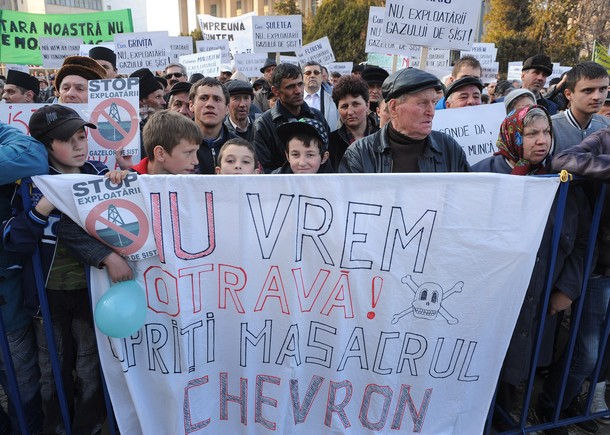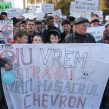
Chevron Postpones Shale Gas Exploration in Romania
Publication: Eurasia Daily Monitor Volume: 9 Issue: 71
By:

After Bulgaria (see EDM, January 24), Romania might unnecessarily miss its own chance to explore a promising shale gas potential in partnership with the Chevron Corporation. Unlike the Bulgarian situation, Romanian protests against shale gas exploration are peripheral, outside the political system, and not backed by significant ecological groups.
On April 3, at the first whiff of local protest, Chevron-Romania announced a one-year postponement of exploration for shale gas. Protesters had apparently assumed that the start of exploration drilling was imminent. Whether this was actually the case or not, Chevron-Romania announced that it would only conduct a seismic data survey during the next 12 months, and engage in a dialogue with citizens and policymakers during this period. The company proposes to address environmental safety concerns while clarifying the economic benefits associated with this energy source (Chevron-Romania press release, April 3).
Under agreements with the Romanian government, Chevron holds four concession perimeters for shale gas exploration and production. One concession, which Chevron took over from British-based Regal Petroleum in 2010, is located in north-eastern Romania’s Vaslui county. The other three are located onshore on the Black Sea littoral at Costinesti, Vama Veche and Adamclisi, all near the Bulgarian border (EurActiv, April 5).
The Romanian government approved the package of three concession agreements on March 20 and made its decision public in the official gazette on March 28; through this step the Chevron concessions entered into legal force. In the lead-up to that date, thousands of people attended several protest demonstrations in Vaslui county’s town of Barlad. Small protests followed in the village of Vama Veche and finally on March 30, in downtown Bucharest, with a mere 100 attending. The initiators acted as “a group of citizens” who invited ecological NGOs to join the protests; i.e., this was not an initiative of Romanian ecological organizations. Protesters demanded: suspension of the concession agreements, publication of their terms (including commercial secrets), an environmental impact report prior to any drilling, and (irrespective of that) a preventive legal ban on hydraulic fracturing in Romania (Focus Energetic, March 26; Jurnalul National, March 23, April 2, HotNews, April 6).
The Bucharest protesters’ banner read: “We are not a Wild West for American investments.” In Romania’s circumstances (unlike elsewhere), environmental causes are not associated with resistance to foreign investment as such, let alone with anti-Americanism. That slogan suggested a political, rather than ecological motivation on the organizers’ part.
Vaslui County is a deeply impoverished area, with subsistence-level agriculture and no development prospects other than Chevron’s shale gas project. Within that county, the town of Barlad (population 70,000) has become the epicenter of resistance to shale gas development in Romania. This is not spontaneous. The Social-Democrat mayor’s political machine has mobilized thousands of residents (civil servants, state-employed workers, whole school classes, “and priests”) to march against this project. According to the provincial media, “a political battle [against shale gas] is in full swing, exploiting the population’s naivete, stirring up hysteria” (Evenimentul Regional al Moldovei, March 20; Realitatea.net, April 2).
Conversely, the three localities on the Black Sea littoral are ecologically sensitive: Costinesti and Vama Veche are summer beach resorts, while Adamclisi is the location of a spectacular Roman monument and Romanian national landmark. But there seems to be nary a mention of these concerns in the Romanian debate, such as it is, over the Chevron project. It is an election year in Romania and the politicians seem hesitant to take a stand on this issue, one way or another. The Romanian parliament in any case seems unlikely to impose a moratorium on shale gas exploration as the Bulgarian parliament recently did (EDM, January 24).
The Romanian government is clearly supportive of Chevron’s project. According to Prime Minister Mihai Razvan Ungureanu and other officials, the issue of an environmental permit for shale gas exploration drilling may become topical two years hence, during which time the appropriate environmental studies will be conducted and debated. Romania’s National Agency for Mineral Resources (ANRM) is Chevron’s direct partner in the concession agreements. According to ANRM’s president, Alexandru Patruti, hydraulic fracturing has been used for decades in Romania and other countries, albeit not for shale gas. This method’s environmental impact has been controlled and minimized through existing best-practices in the process of vertical drilling. It is not the fracking as such, but the horizontal drilling that will require special precautions, according to ANRE’s chief (HotNews, April 9).
Romanian authorities recently hosted a high-profile international conference to address environmental concerns associated with shale gas production and to highlight its economic benefits. Goldwyn Global Strategies, led by David L. Goldwyn, former assistant to US Secretary of State Hillary Clinton on energy issues, organized this three-day event in Bucharest, within the US-backed Shale Gas Global Initiative (Focus Energetic, March 26). Romanian authorities need to reach out proactively to wider public opinion circles on this issue, regardless of the upcoming elections.




